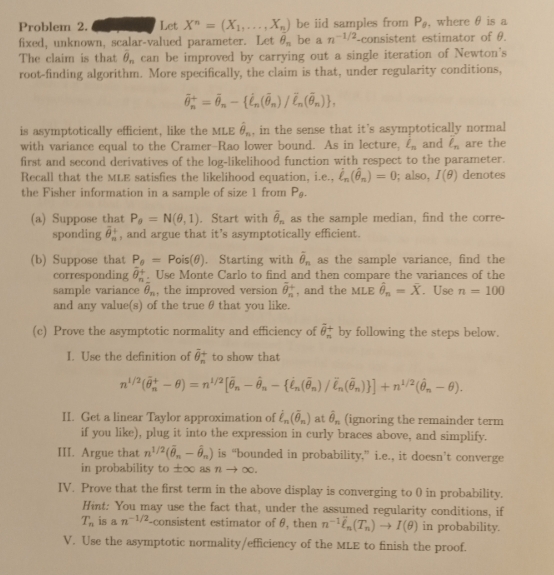Answered step by step
Verified Expert Solution
Question
1 Approved Answer
Problem 2. Let X (X1,...,X) be iid samples from Pe, where 6 is a fixed, unknown, scalar-valued parameter. Let 6, be a n-1/2-consistent estimator

Problem 2. Let X" (X1,...,X) be iid samples from Pe, where 6 is a fixed, unknown, scalar-valued parameter. Let 6, be a n-1/2-consistent estimator of 0. The claim is that 0, can be improved by carrying out a single iteration of Newton's root-finding algorithm. More specifically, the claim is that, under regularity conditions, is asymptotically efficient, like the MLE 6, in the sense that it's asymptotically normal with variance equal to the Cramer-Rao lower bound. As in lecture, l, and , are the first and second derivatives of the log-likelihood function with respect to the parameter. Recall that the MLE satisfies the likelihood equation, i.e., (en) = 0; also, I(9) denotes the Fisher information in a sample of size 1 from Pe. === (a) Suppose that P, N(0, 1). Start with 6, as the sample median, find the corre- sponding, and argue that it's asymptotically efficient. (b) Suppose that P corresponding = Pois(0). Starting with e, as the sample variance, find the Use Monte Carlo to find and then compare the variances of the sample variance n, the improved version 0, and the MLE X. Use n = 100 and any value(s) of the true 6 that you like. (c) Prove the asymptotic normality and efficiency of + by following the steps below. I. Use the definition of to show that n1/2 (0-0)=n/2[0-8 - {in (n) /n (n)}]+n/2 (0-0). II. Get a linear Taylor approximation of (0) at 6, (ignoring the remainder term if you like), plug it into the expression in curly braces above, and simplify. III. Argue that n1/2(0-6) is "bounded in probability," i.e., it doesn't converge in probability to too as n o. IV. Prove that the first term in the above display is converging to 0 in probability. Hint: You may use the fact that, under the assumed regularity conditions, if T, is a n-1/2-consistent estimator of 6, then n(T) 1(0) in probability. V. Use the asymptotic normality/efficiency of the MLE to finish the proof.
Step by Step Solution
There are 3 Steps involved in it
Step: 1

Get Instant Access to Expert-Tailored Solutions
See step-by-step solutions with expert insights and AI powered tools for academic success
Step: 2

Step: 3

Ace Your Homework with AI
Get the answers you need in no time with our AI-driven, step-by-step assistance
Get Started


